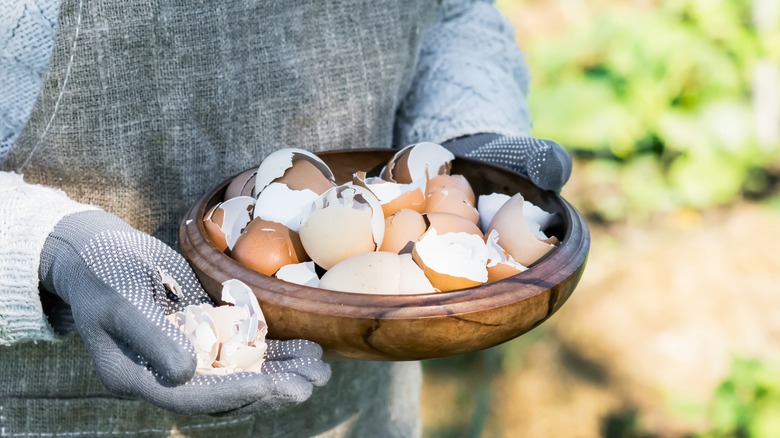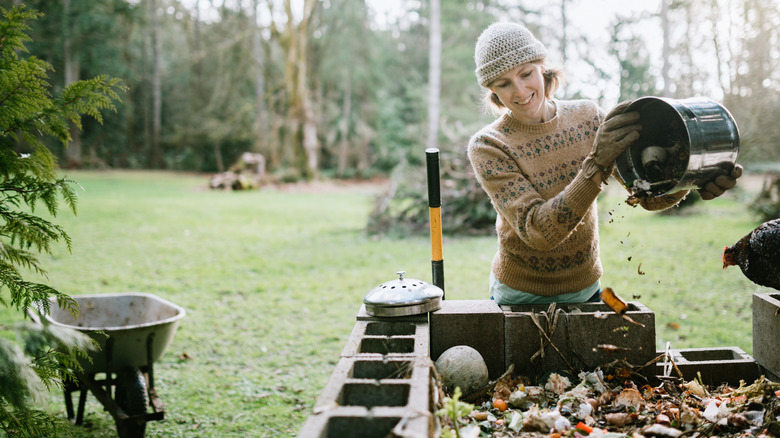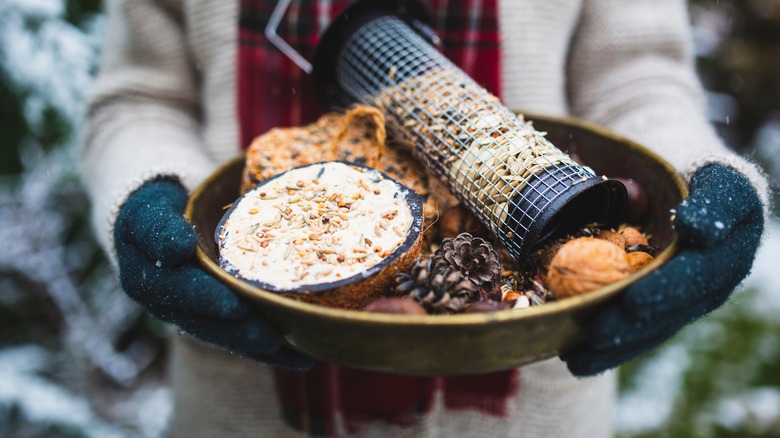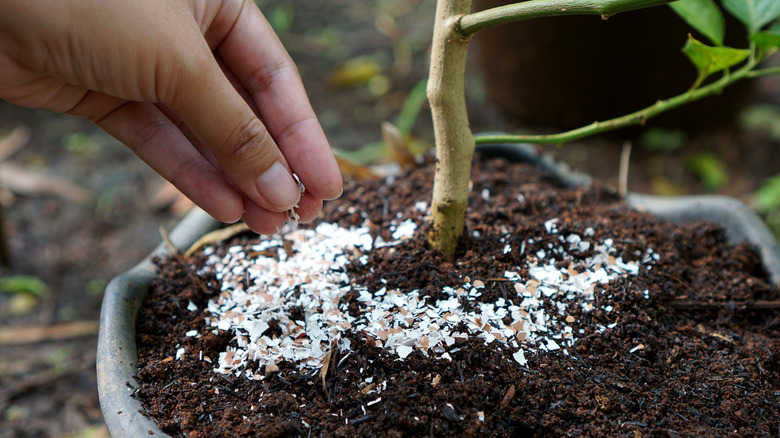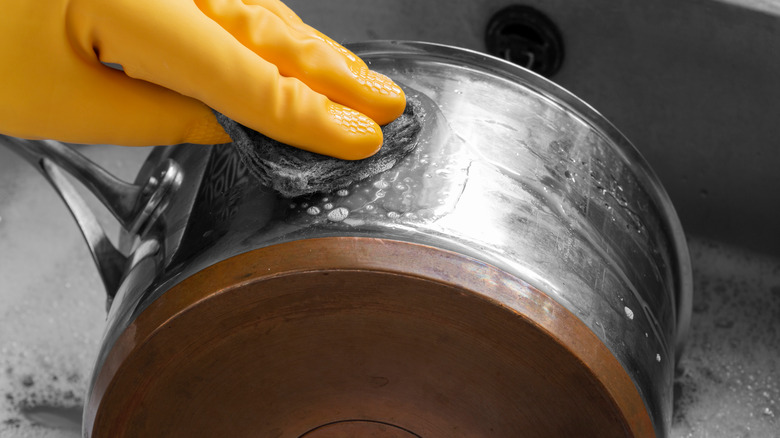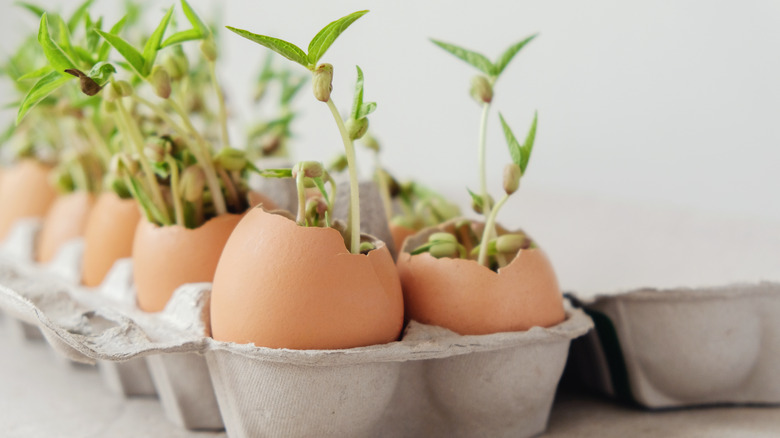Unexpected Uses For Eggshells Around Your Home And Garden
Maybe you're on a zero-waste journey and looking for ways to live more sustainably. Or, you just want to eat eggs every morning without feeling guilty about all the shells filling up your trash can. Whatever your motivation, finding ways to repurpose eggshells is a worthwhile mission. Here's a sobering fact from the FDA: if you look at all the materials collected in U.S. landfills by volume, food waste is at the very top of the list. (Yup, more scraps are dumped into landfills than plastic!)
Diverting your household's used eggshells from landfills is just one small way to do your part for planet Earth. But let's be clear, finding ways to repurpose them isn't just a selfless act of environmental consciousness. There are some practical and potentially money-saving ways to reuse the shells around your home. They are commonly used in the care of both indoor and outdoor plants because they're loaded with calcium and are compostable. If that's not enough, they can even be transformed into gallery-worthy art! So, stock up on your next trip to the farmer's market. You'll need a lot of eggshells if you're going to try these all.
Add them to composting bins
If you have a green thumb, you may already know that today's used eggshells can help you grow healthy plants for many years to come. Keeping food waste out of landfills is just one of the many benefits of home composting. Eggshells are great for your compost because they're packed with calcium and other nutrients. The EPA describes four essential ingredients for a balanced compost pile. Those ingredients are water, air, carbon-rich materials ("browns"), and nitrogen-rich materials ("greens"). Eggshells are considered greens.
Leftover shells can also be used for vermicomposting. This method uses worms to break down organic matter into compost. One perk of using a worm compost bin is that they can even be kept indoors, assuming you're not squeamish about creepy crawlies.
Using eggshells in composting is pretty simple. The only way you could go wrong is by adding big pieces of shell to your backyard compost pile or worm composting bin. It may take a year or longer for big pieces of shell to break down. Plus, breaking them into small pieces allows you to mix them evenly into your compost. The smaller the better! Ideally, eggshells bound for the compost pile are crushed into powder. A coffee grinder or spice grinder will work. You can always boil the shells first if you're concerned about salmonella. However, a composting pile should get hot enough to kill any of the pathogens that could potentially linger on unwashed shells.
Help birds get enough calcium
For humans, eating a piece of eggshell usually means someone wasn't paying close attention while cooking. For mama birds, eating eggshells can be an important part of growing healthy babies. Adding crushed eggshells to birdseed can help wild birds boost their calcium, an essential element for some nesting types. You could also buy calcium-enriched food for them, but repurposing your old eggshells might be a more cost-effective strategy.
Like using eggshells in composting, eggshells used for feeding birds should be thoroughly crushed. Baking the shells over low heat first dries them out and makes them easier to pulverize. To try it, the National Audubon Society suggests spreading rinsed eggshell pieces (from chicken eggs) onto a cookie sheet. Bake them for about 10 minutes at 250 degrees Fahrenheit. Watch them closely and pull them out of the oven if they start to turn brown. Once cool, crush the shells into powder. Mix the powder with birdseed and put the mixture into a feeder or sprinkle it on the ground in areas where you see birds gather to eat.
Create eggshell mosaic art
Do you technically need art made out of eggshells in your home? Maybe not. But, it could be a fun and budget-friendly project for a rainy day. Break shells into small pieces and voila: DIY mosaic tiles! Glue them onto paper or use them to decorate things like flower pots or plain picture frames. Happily, this budget-friendly craft project is appropriate for kids or adults of all artistic skill levels. There's no "wrong" way to design a piece of mosaic art, after all.
To make eggshell mosaics, always start with clean eggshells. Break them apart with your hands to create whatever size pieces you want. Craft glue should be strong enough to adhere lightweight eggshells to paper. The easiest strategy to make a striking piece of art is to use plain old white or brown eggshells on a base of a different color. For example, TikToker @blompling created a delicate bird using white eggshells glued to a blue background. If you want more color, use Easter egg dye to tint the big pieces of the shells before breaking them into smaller pieces. Finally, be mindful of safety if kids are participating. They should be responsible enough to handle small pieces without putting them in their mouths. If you're organizing a craft project for other people's kids, make very sure that no one has an egg allergy. Even handling the shells can be harmful for someone with a severe allergy.
Treat calcium-deficient plants
Used in compost, eggshells can help you grow healthy plants from the roots up. But what about using them to rehab a garden that's struggling? Eggshells can be applied to calcium-deficient plants to give them an extra boost of vital nutrients. Calcium plays a role in some important functions for growing plants. It's an essential part of creating cell wall structures and also helps plants tolerate cold temperatures. Tomato and pepper plants are commonly afflicted by calcium deficiency.
How do you know if a plant is struggling with calcium deficiency and might benefit from some extra love? First, know that it might be a result of acidic soil. (A soil testing kit may help you confirm.) Signs of calcium deficiency include twisted or bushy-looking young leaves, and the appearance of brown or black spots on young leaves. If eggshells are crushed into a fine powder, you can try mixing the powder directly into the soil of ailing plants. This isn't an immediate solution for calcium deficiency, though. Making a water-soluble calcium-rich fertilizer from eggshells and white vinegar could speed up the process. Spray it directly onto the leaves for quicker uptake as the nutrients should penetrate the plants more quickly.
Make tiny planters for (tiny!) succulents
Make an omelet and an adorable succulent garden from the same few eggs! Eggshells might not be the ideal vessel for live succulents long-term, since they're organic and will eventually start to decompose. But, do you want a minimalist centerpiece the next time you have people over for dinner? Succulents planted in eggshells are bound to be a conversation starter.
TikToker @cookwithmanuela gives a good overview of the process, which does require pretty steady hands. The key is to crack your eggs very strategically to keep as much of the shell intact as possible. Wash and dry them, then carefully scoop potting soil inside each egg before tucking tiny succulents in there. (You can always use faux succulents if you want — who's going to know?) Sprinkle the plants with water and wipe down the shells. Manuela nestled a group of eggshell planters into a shallow dish covered with decorative pebbles. You could also try using sand or potting soil as a stable base for a cluster of these tiny and adorable planters.
Use them as an abrasive to scrub pots and pans
You know that gritty texture that makes eggshells so unpleasant to bite into? That could be exactly what you need to rid your pots and pans of stubborn residue. Scrubbing cookware with finely ground eggshells could be a (free!) solution for cooked-on gunk and scorch marks.
To try it, grind up clean eggshells, sprinkle them over a grimy pan, and then scrub as normal with dish soap and water. There are some caveats here, though. First, eggshells must be crushed into a pretty fine powder. Not only because that will make them most effective as an abrasive, but also for the sake of your plumbing system. Big pieces of eggshell are one of the things that plumbers often say will clog drains. Second, ensure your pots and pans are safe for cleaning with abrasives before attempting this. For example, non-stick pans can scratch easily. So, scrubbing your favorite ceramic skillet with gritty eggshells is probably not a good idea.
Give seedlings a place to sprout
Planting seedlings in clean, empty eggshells is kind of a double whammy from a sustainability standpoint. This project lets you repurpose both the shells and the container the eggs came in. It's a great way for kids to learn about plants, but gardeners of any age can use this trick to get seedlings started. Bonus: you can write the names of plants on the shells themselves to keep track of what's what!
Want to use eggshells to nurture new seedlings? It's important to crack eggs very carefully to keep the shells mostly whole. The shells will also need drainage holes in the bottom which can be created using a pin or needle. Boil shells in a pot of water to clean them and kill any bacteria clinging to them. Fill each shell about two-thirds with potting soil, add seeds, and cover with more soil. Follow the instructions on your seed packets for specific guidance about things like the number of seeds you should use for each seedling. Next, water the soil. An eye dropper or turkey baster may be helpful for navigating the small openings of each little egg. Place the carton full of planters somewhere that's warm and has sun exposure. Once your new baby plants have sprouted some leaves, gently break off the eggshell and replant them in larger pots.

